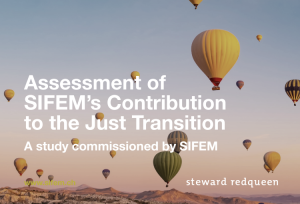Conversation Series: CSRD is only the tip of the iceberg with Magdalena Krzysztofik
Meet Magdalena Krzysztofik, Senior Consultant, and Danijela Piljic, Manager – who jointly spearhead policy and regulation efforts at Steward Requeen. In this Conversation Series, they sat down to discuss why the CSRD will be a game changer not only for corporate sustainability reporting but also for the way companies approach and manage sustainability more broadly.
Danijela: If you were to highlight one regulation poised to revolutionise the way in which companies manage sustainability, what would it be?
Magdalena: I would point to the Corporate Sustainability Reporting Directive (CSRD), which came into effect on January 1, 2024. Its main objective is to standardise sustainability reporting. It should provide users of sustainability information – particularly investors – with reliable and more comparable insights into how companies are managing material sustainability risks and opportunities and how they are addressing the impact they have on people and the planet. But I think it will usher a much bigger change in the broader approach to sustainability management.
D: Why is this considered such a significant shift? We’ve had regulatory frameworks already that imposed certain sustainability disclosures for companies within its scope, like the Non-financial Reporting Directive – the predecessor to the CSRD.
M: It’s true. Sustainability reporting has been already subject to regulations but never in such a comprehensive manner. The changes introduced by the CSRD go beyond expanding the number of companies covered and changing the scope of information that they will have to disclose. It also requires adherence to certain fundamental principles, such as the double materiality perspective requiring companies to report both on how their business is impacted by sustainability matters (financial materiality) and how their activities impact the environment and society at large (impact materiality). This will likely have a profound and far-reaching impact that goes beyond mere reporting.
D: Reporting is only the tip of the iceberg, then?
M: Indeed. When most people think of the CSRD they tend to focus on aspects like double materiality assessment, data collection, and reporting. However, there are deeper layers underneath it that are not immediately visible, such as sustainability strategy and governance, or policies, action plans, and targets related to material sustainability issues. It’s important to note that CSRD doesn’t mandate companies to have all these elements in place. Nonetheless, if a company has not adopted certain policies or targets it will have to disclose it. The absence of these elements is an important piece of information to the users of sustainability statements as it hints at potential management gaps. These kinds of insights will be readily available now to investors. This in turn should prompt companies to reassess their broader sustainability approach and implement necessary improvements.
D: Would you argue that sustainability reporting is not an end in itself but rather a means to an end, then?
M: Absolutely. You can’t effectively manage what you don’t measure, and you can’t report what you haven’t managed. Reporting is only the last step of a more complex process. Under CSRD, the starting point of the process is a double materiality assessment. This initial step is paramount, providing a comprehensive overview of a company’s sustainability footprint, and a foundation upon which other efforts should be based.
D: It also seems to require significant level of organisation readiness, doesn’t it?
M: It’s true, even for more advanced companies, this can pose a challenge as it requires a deep understanding of ESG issues as well as sector-specific and company-specific circumstances. Furthermore, companies will have to look at sustainability issues using both financial materiality as well as an impact materiality lens, while considering not only their own operations but also their upstream and downstream value chain. Finally, it will also necessitate adopting a more forward-looking perspective, rather than looking at sustainability issues in hindsight. This last aspect is particularly crucial, and I expect it to yield strategic insights that can be used to inform broader business strategy, risk management and operational decision-making.
D: In other words, double materiality assessment will help to bring focus not only to the reporting process but also to the overall sustainability management?
M: Correct. In the past, we have seen companies disclosing all sorts of information, whether material or not. There was also a tendency to obscure certain management gaps by reporting excessive or irrelevant information. This lack of focus was visible as well on the management side with sustainability efforts often being dispersed, priorities remaining ambiguous, and the link to the overarching strategy and business model missing. This will change now. The introduction of the double materiality assessment forces companies to think hard about what truly matters. Issues that don’t meet the established materiality threshold should not be reported. The methodology underpinning this process should be carefully considered as it will be subject to external audit. Consequently, companies will be held accountable only for the issues that are material to their business, necessitating the formulation of management strategies tailored to prioritise these aspects.
D: Any advice for the companies embarking on this journey?
M: My advice would be to view this process not merely as a compliance exercise, but as an opportunity to extract value for your company. It can serve as a catalyst for enhancing cross-functional collaboration, re-assessing existing sustainability strategy and governance structures, and discussing efforts that ought to be prioritised. I would also try to anticipate investors’ expectations and be honest and transparent. This is not a one-time exercise that you have to get right straight away. Rather, it demands a strategic approach. Demonstrate that you have a plan and take incremental steps to improve areas that are not sufficiently addressed. In the long run, these steps will boost your resilience and position your business more favourably in a market that is increasingly oriented towards sustainable business practices.
Whether you are directly or indirectly affected by the CSRD, Steward Redqueen can help you to comply with the requirements. We will help you elevate your understanding of the CSRD, discover and tackle compliance gaps and perform double materiality assessment. We also offer all-encompassing CSRD-compliance solution to support you at every step of the journey.
For more information reach out to danijela.piljic@stewardredqueen.com or magdalena.krzysztofik@stewardredqueen.com


















